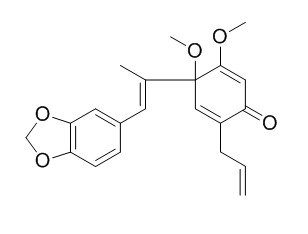Futoquinol
Futoquinol is an anti-platelet activating factor principle from the stem part of Piper futokadsura (Piperaceae), the Chinese drug haifengteng. Futoquinol has anti-neuroinflammatory activity, it can potently inhibit NO production with an IC(50) value of 16.8 microM in microglia cells. Futoquinol shows potent inhibition of PMA-induced ROS production in human polymorphonuclear neutrophils with IC(50) values 13.1 +/- 5.3 microM.
Inquire / Order:
manager@chemfaces.com
Technical Inquiries:
service@chemfaces.com
Tel:
+86-27-84237783
Fax:
+86-27-84254680
Address:
1 Building, No. 83, CheCheng Rd., Wuhan Economic and Technological Development Zone, Wuhan, Hubei 430056, PRC
Providing storage is as stated on the product vial and the vial is kept tightly sealed, the product can be stored for up to
24 months(2-8C).
Wherever possible, you should prepare and use solutions on the same day. However, if you need to make up stock solutions in advance, we recommend that you store the solution as aliquots in tightly sealed vials at -20C. Generally, these will be useable for up to two weeks. Before use, and prior to opening the vial we recommend that you allow your product to equilibrate to room temperature for at least 1 hour.
Need more advice on solubility, usage and handling? Please email to: service@chemfaces.com
The packaging of the product may have turned upside down during transportation, resulting in the natural compounds adhering to the neck or cap of the vial. take the vial out of its packaging and gently shake to let the compounds fall to the bottom of the vial. for liquid products, centrifuge at 200-500 RPM to gather the liquid at the bottom of the vial. try to avoid loss or contamination during handling.
Nutrients.2023, 15(12):2644.
Molecules.2017, 22(2)
Biomed Pharmacother.2020, 128:110318.
Vietnam Journal of Food Control.2022, 5(2): 115-128.
Pharmaceuticals (Basel).2024 Feb 24;17(3):292.
Cell Chem Biol.2019, 26(1):27-34
J Colloid Interface Sci.2022, 622:298-308.
Cells.2021, 10(11):2919.
J Appl Microbiol.2022, 132(2):949-963.
Current Enzyme Inhibition2023, 19(1):55-64(10)
Related and Featured Products
Bioorg Med Chem Lett. 2010 Jan 1;20(1):409-12.
Neolignans from Piper kadsura and their anti-neuroinflammatory activity.[Pubmed:
19900811 ]
METHODS AND RESULTS:
Bioassay-guided column chromatographic separation of the methanolic extract of dried aerial parts of Piper kadsura (Piperaceae) led to the isolation of a new neolignan, piperkadsin C (1), together with eight known neolignans (2-9). The structures of the isolated compounds were elucidated by combined spectroscopic methods. The anti-neuroinflammatory activities of these compounds were evaluated by assessing nitric oxide (NO) production in LPS-activated BV-2 cells, a microglia cell line.
CONCLUSIONS:
Piperkadsin C (1) and Futoquinol (2) potently inhibited NO production with an IC(50) value of 14.6 and 16.8microM in microglia cells, respectively. Compounds 3, 4, 5, 8, and 9 also exhibited moderate inhibition of NO production in BV-2 cells.
J Nat Prod. 2006 May;69(5):842-4.
Anti-inflammatory neolignans from Piper kadsura.[Pubmed:
16724856 ]
METHODS AND RESULTS:
Two new neolignans, piperkadsin A (1) and piperkadsin B (2), as well as 11 known neolignans, three known alkaloids, the highly oxygenated compound (+)-crotepoxide, and stigmasterol were isolated from the stems of Piper kadsura. The anti-inflammatory activities of these compounds were evaluated.
CONCLUSIONS:
Compounds 1, 2, Futoquinol (3), piperlactam S (4), and N-p-coumaroyl tyramine (5) showed potent inhibition of PMA-induced ROS production in human polymorphonuclear neutrophils with IC(50) values 4.3 +/-1.0, 12.2 +/- 3.2, 13.1 +/- 5.3, 7.0 +/- 1.9, and 8.4 +/- 1.3 microM, respectively.
Zhongguo Zhong Yao Za Zhi. 1993 May;18(5):292-4, 318.
Anti-platelet activating factor constituents, 2,5-diaryltetrahydrofuran type lignans, from Piper futokadsura Sied. et Zucc.[Pubmed:
8216803]
METHODS AND RESULTS:
Besides the known components kadsurenone, Futoquinol and futoxide, three anti-platelet activating factor principles have been found from the stem part of Piper futokadsura (Piperaceae), the Chinese drug haifengteng. They were separated and identified as galgravin, galbelgin and veraguensin on the basis of HPLC and spectral analysis.
CONCLUSIONS:
The natural existence of these three anti-PAF constituents in haifengteng is reported for the first time.



